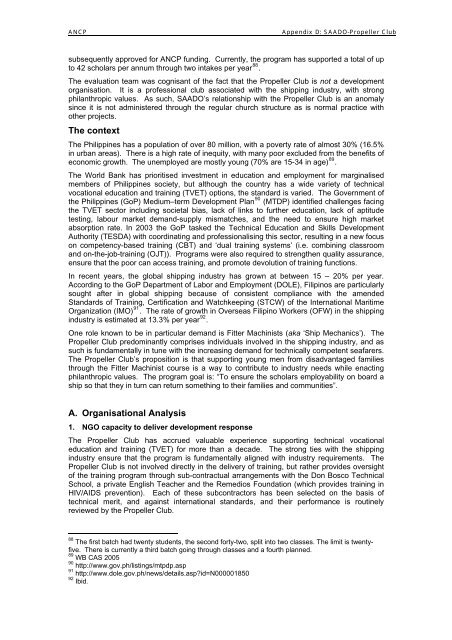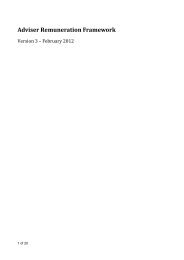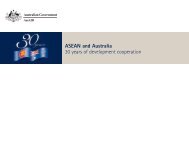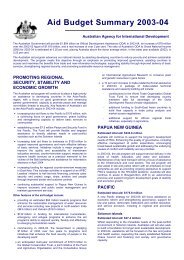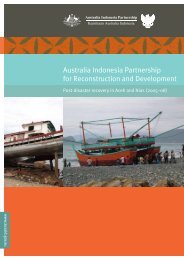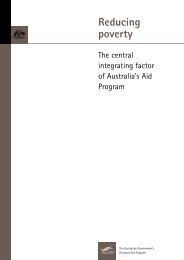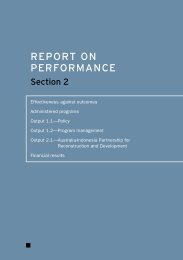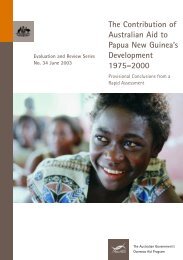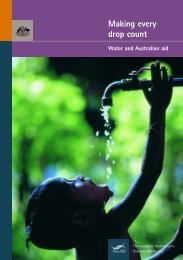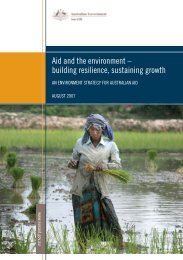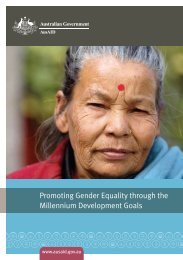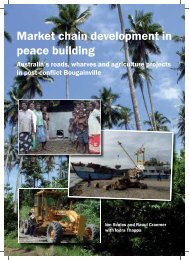<strong>ANCP</strong>Appendix D: SAADO-Propeller Clubsubsequently approved for <strong>ANCP</strong> funding. Currently, the program has supported a total of upto 42 scholars per annum through two intakes per year 88 .The evaluation team was cognisant of the fact that the Propeller Club is not a developmentorganisation. It is a professional club associated with the shipping industry, with strongphilanthropic values. As such, SAADO’s relationship with the Propeller Club is an anomalysince it is not administered through the regular church structure as is normal practice withother projects.The contextThe <strong>Philippines</strong> has a population of over 80 million, with a poverty rate of almost 30% (16.5%in urban areas). There is a high rate of inequity, with many poor excluded from the benefits ofeconomic growth. The unemployed are mostly young (70% are 15-34 in age) 89 .The World Bank has prioritised investment in education and employment for marginalisedmembers of <strong>Philippines</strong> society, but although the country has a wide variety of technicalvocational education and training (TVET) options, the standard is varied. The Government ofthe <strong>Philippines</strong> (GoP) Medium–term Development Plan 90 (MTDP) identified challenges facingthe TVET sector including societal bias, lack of links to further education, lack of aptitudetesting, labour market demand-supply mismatches, and the need to ensure high marketabsorption rate. In 2003 the GoP tasked the Technical Education and Skills DevelopmentAuthority (TESDA) with coordinating and professionalising this sector, resulting in a new focuson competency-based training (CBT) and ‘dual training systems’ (i.e. combining classroomand on-the-job-training (OJT)). Programs were also required to strengthen quality assurance,ensure that the poor can access training, and promote devolution of training functions.In recent years, the global shipping industry has grown at between 15 – 20% per year.According to the GoP Department of Labor and Employment (DOLE), Filipinos are particularlysought after in global shipping because of consistent compliance with the amendedStandards of Training, Certification and Watchkeeping (STCW) of the International MaritimeOrganization (IMO) 91 . The rate of growth in Overseas Filipino Workers (OFW) in the shippingindustry is estimated at 13.3% per year 92 .One role known to be in particular demand is Fitter Machinists (aka ‘Ship Mechanics’). ThePropeller Club predominantly comprises individuals involved in the shipping industry, and assuch is fundamentally in tune with the increasing demand for technically competent seafarers.The Propeller Club’s proposition is that supporting young men from disadvantaged familiesthrough the Fitter Machinist course is a way to contribute to industry needs while enactingphilanthropic values. The program goal is: “To ensure the scholars employability on board aship so that they in turn can return something to their families and communities”.A. Organisational Analysis1. NGO capacity to deliver development responseThe Propeller Club has accrued valuable experience supporting technical vocationaleducation and training (TVET) for more than a decade. The strong ties with the shippingindustry ensure that the program is fundamentally aligned with industry requirements. ThePropeller Club is not involved directly in the delivery of training, but rather provides oversightof the training program through sub-contractual arrangements with the Don Bosco TechnicalSchool, a private English Teacher and the Remedios Foundation (which provides training inHIV/AIDS prevention). Each of these subcontractors has been selected on the basis oftechnical merit, and against international standards, and their performance is routinelyreviewed by the Propeller Club.88 The first batch had twenty students, the second forty-two, split into two classes. The limit is twentyfive.There is currently a third batch going through classes and a fourth planned.89 WB CAS 200590 http://www.gov.ph/listings/mtpdp.asp91 http://www.dole.gov.ph/news/details.asp?id=N00000185092 Ibid.<strong>ANCP</strong> <strong>Philippines</strong> <strong>Cluster</strong> <strong>Evaluation</strong> <strong>Report</strong> (ver. 2.0)XXXIX
<strong>ANCP</strong>Appendix D: SAADO-Propeller ClubSAADO staff indicated that the Propeller Club was amongst their strongest implementingpartners in terms of reporting, accountability and financial management. The club employstwo fulltime staff members who act as a secretariat, and have primary responsibility foradministering the scholarship program. The club is managed by a board, whose membershave direct responsibility and oversight of the scholarship program. For example, the club’streasurer is also the program’s accountant. The Program Director is an Australian withpersonal links to SAADO. He is a qualified engineer, has extensive management experienceand personal knowledge of Australian technical training standards. Club members attributedthe professionalisation and increased enrolment of Propeller Club scholars to his drive andvision. Nevertheless, there appeared to be wider ownership of the program among boardmembers, all of whom occupy executive positions within shipping industry companies. Therewas a sense that the scholarship program had come to define the raison d’etre of the club.Time invested by Propeller Club members, including the Program Director, is voluntary, andin his case, represents a substantial commitment. The club board advised the evaluationteam that they were conscious of their capacity limits, and hence were unlikely to expand theprogram beyond two intakes per year.SAADO has some prior experience in designing and supporting TVET programs 93 , and haspreviously administered projects in the <strong>Philippines</strong> 94 . The church’s mission and structureensure that the project has reach within poor communities throughout the <strong>Philippines</strong> for thepurpose of recruiting scholars.SAADO was re-accredited from full to base level in 2006. The evaluation team observedrelatively informal systems for project identification, monitoring and reporting that areconsistent with this level of accreditation 95 . There seemed to be a predominant reliance onpersonal relationships to ensure program integrity, rather than ‘organisational systems’. Atthe time of this evaluation, the future of SAADO was uncertain within the SAA structure,owing in part to the departure (February 2008) of two of the three fulltime staff members 96 .The remaining staff member was overextended while the church considered the future of thedevelopment office. This situation appeared to place undue stress on the sole staff member,and was cause for concern about organisation’s capacity to administer a portfolio of projects.However, the evaluation team deemed that SAADO’s capacity over the previous 3 years ofthe Propeller Club project to be satisfactory for a base agency.The organisational capacity of the SAADO-Propeller Club partnership is rated satisfactory.2. Strategies for ensuring quality partnershipsThere was no prior history between the Propeller Club and SAADO, and there is no formalcommitment to continuing funding beyond the current phase. The partnership is opportunisticin the sense that SAADO had identified the <strong>Philippines</strong> as a target country in their strategicplan 97 , and the Propeller Club was seeking a sympathetic small-scale donor to support anincrease in the number of scholars. The organisational partnership arose from a personalrelationship between the SAADO Director and the Propeller Club Scholarship ProgramDirector.Nevertheless, there appears to have been strong alignment between the organisationalvalues and purpose of the partner organisations. That is, the philanthropic values of thePropeller Club are consistent with the SAADO mission. Further, the active and voluntaryengagement of the Salvation Army Church in the <strong>Philippines</strong> as key partners in the93 A technical training program was previously implemented in Zambia, and was regarded as successful.94 In the mid-1990s a number of small projects were supported through the SA church structureincluding: a mobile health clinic, micro credit, water supply and rice mill.95 N.B. The evaluation team was advised of new project cycle management protocols recently adoptedat the international level and in the process of being rolled out. This suggests a commitment toincreasing the professionalism of agency functions.96 The recently departed staff members included an administrative support person and the Director thathad built up SAADO since inception. At the time of this evaluation the SAA leadership was discussingthe future structure and staffing of SAADO. Evidently, while international development has been valuedby the SAA leadership, it has not always been understood compared with the domestic social activitiesfor which the SAA is well regarded.97 As it is within their regional ‘zone’ and therefore geographic area of interest.<strong>ANCP</strong> <strong>Philippines</strong> <strong>Cluster</strong> <strong>Evaluation</strong> <strong>Report</strong> (ver. 2.0)XL


